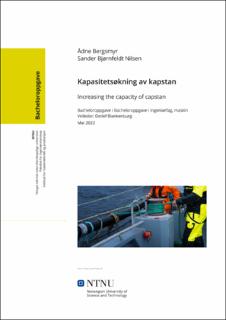| dc.contributor.advisor | Blamkenburg, Detlef | |
| dc.contributor.author | Bergsmyr, Ådne | |
| dc.contributor.author | Nilsen, Sander Bjørnfeldt | |
| dc.date.accessioned | 2022-07-02T17:20:03Z | |
| dc.date.available | 2022-07-02T17:20:03Z | |
| dc.date.issued | 2022 | |
| dc.identifier | no.ntnu:inspera:108211148:112076534 | |
| dc.identifier.uri | https://hdl.handle.net/11250/3002378 | |
| dc.description.abstract | Oppgavens mål har vært å øke kapasiteten til PMH’s 3 tonns kapstan med 20%, ved å videreutvikle eksisterende kapstanhode. Prosjektet har som hensikt å bedre PMH’s posisjon i markedet for kapstaner og lette arbeidet til operatøren.
På bakgrunn av produktkravspesifikasjonene ble det utviklet konsepter som ble vurdert opp mot hverandre. Av sju konsepter ble konseptene med vertikale ribber og vertikale riller valgt for videre utvikling. Disse to konseptene bygde på samme teori om at deformasjonen av tauet skaper en friksjonsøkning som videre gir en kapasitetsøkning. De to løsningene ble designet i SolidWorks, 3Dprintet og testet i småskala.
Testing av vertikale riller ga ikke en tilstrekkelig kapasitetsøkning, sannsynligvis på grunn av lite deformasjon av tauet. Testresultatene til de vertikale ribbene bekreftet informasjonen prosjektgruppen hadde funnet i litteraturanalysen og ga grunnlag til videreutvikling. Videre arbeid med definering av endelig løsning ble utført og løsningen prosjektgruppen kom frem til er et kapstanhode med avrundede ribber. Denne vil gi den ønskede kapasitetsøkningen, og teorien underbygger påstanden om lite tauslitasje, og lite aksiell friksjon. De vertikale ribbene ga kapstanhodet en estetikk som er å anse som like pen som det originale kapstanhodet. | |
| dc.description.abstract | The project goal has been to increase the capacity of PMH's 3-ton capstan head by 20%, by further developing an existing product. The purpose of the project is to improve PMH's position in the market for captains and facilitate the work of the operator.
Based on the product requirements specifications, concepts were developed that were evaluated against each other. Of the seven concepts, the concepts with vertical ribs and vertical grooves were chosen for further development. These two concepts were based on the same theory that the deformation of the rope creates an increase in friction which further gives an increase in capacity. The two solutions were designed in SolidWorks, 3Dprinted and tested on a small scale.
Testing of vertical grooves did not provide a sufficient capacity increase, probably due to little deformation. The test results of the vertical ribs confirmed the information the project group had found in the literature analysis and provided a basis for further development. Further defining of the final solution was carried out and the solution the project group came up with was a capstan head with rounded ribs. This will give the desired capacity increase, and the theory supports the claim of little rope wear and little axial friction. The vertical ribs gave the capstan head an aesthetic that is considered as pretty as the original capstan. | |
| dc.language | nob | |
| dc.publisher | NTNU | |
| dc.title | Kapasitetsøkning av kapstan | |
| dc.type | Bachelor thesis | |
